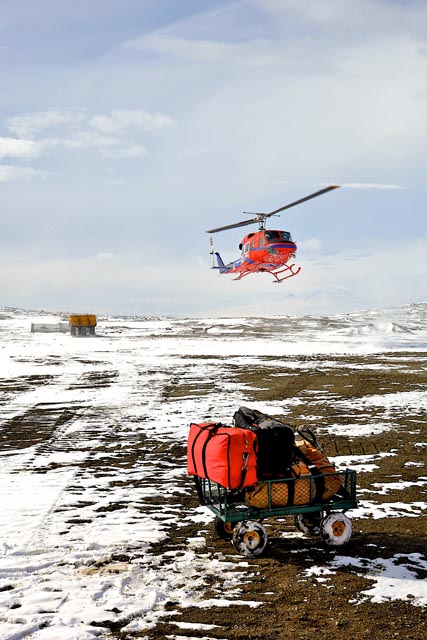|
Page 2/2 - Posted April 12, 2013
4. In addition to your NSF-sponsored trip, you also visited South American research bases in Antarctica. What was that trip about? What contrasts did you see culturally and scientifically? At McMurdo, when you land, usually first it’s Ivan the Terra Bus and then there’s orientation … On King George (or Rey Jorge, as we called it), first things first: when the plane landed, it was time for grappa and cigarettes. I’ll also mention that I came from Patagonia by Lear Jet, and it was hotter than heck inside the plane. It must have been about 90 degrees Fahrenheit. You could have raised bananas in the cockpit. And so we landed and tumbled out, and without any coats on at all and dripping with sweat, I stepped out of the plane into a 60 mph wind with vertical pellets of snow, and man, I about went into shock. It felt colder than any freezer I had ever been inside. I remember thinking, What the hell have I gotten myself into? 5. Part of your original thesis was that “without airplanes and helicopters, science wouldn’t happen.” Why do you think that? It all started with ships, after all. Well, I could just as easily have said, without shotguns and Formaldehyde, or without curiosity and hope. The steady plume that is science today coalesced from many colors of smoke. In my case, I knew that when applying for any kind of grant to NSF, even an arts-based one, the one thing they did NOT want you to say was, “Just send me and I promise to wander around and emote in a vaguely artsy way.” You have to delineate goals and boundaries. Further, I have a dual background, in that I’ve worked as a survey ornithologist and also taught writing in science programs. In New Guinea, doing translations, I traveled in very remote areas, places that had not seen a white guy before. I know that successful field work has a tremendous amount of infrastructure behind it, the background stuff of getting permits and remembering the extra pee bottles and making sure the right equipment makes it on the right cargo flight. It was a story that deserved to be told, and still does in fact, since I have not done as much with that side of it as I had hoped. That can be part of the next book. We should note, too, that wooden ships aside, aviation came early to Antarctica, and not just Scott’s balloon experiment, but things like the Fox Moth brought by the British Graham Land Expedition in the 1930s, which carried out flights from ice and water. It was the Depression then, so they were a bit neglected, and then World War II came, so their story didn’t get properly told. As a private guess, the next stage of aviation will be fewer manned flights and more surveys and perhaps even cargo drops by UAVs. Why haul humans back and forth when we can get so much more done by remote control? … We may some day be as nostalgic for an A-Star chopper as we are now for dog teams or a full crowd of sail. 6. You spent some time with the mechanics and pilots at McMurdo Station. What were your impressions of these men and women? Photo Credit: Dave Grisez/Antarctic Photo Library
A U.S. Air Force C-124 had its nose gear collapse on landing in this 1956 photo. Aviation mishaps were common in the early days of the U.S. Antarctic Program.
I think all of the support staff for the whole program, from Air Force crews in New Zealand, to [the New York] Air National Guard Ever see those bumper stickers, “If You Can Read This, Thank a Teacher”? McMurdo store should sell a T-shirt that says, “If you got here alive, thank your mechanic.” One sort of sub-theme about stories I heard was the “old days versus now,” and what I heard over and over was the general sense that in terms of operational controls, modern-day aviation has too many restrictions. Pointless rules raise my libertarian hackles as much as they do anybody’s, but I have to say, the initial Cold War-era aviation in Antarctica was absurdly hazardous. We lost way more planes than was necessary. There was a lot of buckaroo flying going on, and in terms of bad P.R. back home, that was going to have to stop — restrictions and tighter controls were inevitable. I talk about this a bit in the book, when I mention the numbers of crashes that went on then, or the widely held rumor that helicopter pilots were kidnapping penguins for zoos at home. What matters less than if it ever happened is that everybody is pretty sure it could have happened. 7. Anything you’d like to add? I’ve been to within about 600 miles of the North Pole, on board the two-masted schooner called the Noorderlicht. If anybody wants to offer me a ride the rest of the way, please email me. I’ll bring the cigarettes and the grappa. NSF-funded research in this article: Charles Hood, Antarctic Artists and Writers Program, Award No. 0840109 |



For USAP Participants |
For The Public |
For Researchers and EducatorsContact UsU.S. National Science FoundationOffice of Polar Programs Geosciences Directorate 2415 Eisenhower Avenue, Suite W7100 Alexandria, VA 22314 Sign up for the NSF Office of Polar Programs newsletter and events. Feedback Form |



